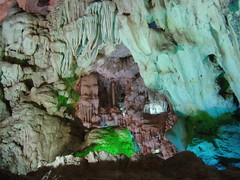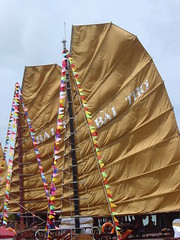Not all the tombs in Vietnam are ancient. Ho Chi Minh is embalmed in this giant masoleum. Uncle Ho has gotten the full Lenin-in-wax treatment that communist countries do so well. It helps that his narrow beard makes him a dead ringer for other revered ancient leaders from Vietnamese history.
Each day large crowds line up to pay respect to the founder of modern Vietnam. We came at lunch when the square was empty and the plaza around the tomb was just enormous. An extremely large flag flies from the center of the square and Socialist sayings fill the walls leading up to the tomb. Other banners around the city exorted some sort of worker of the year competition. Central Hanoi was also where we saw the most Army uniforms on drill or parade. It wasn't quite like a scene from 1984, but it came close.
Saigon was renamed Ho Chi Minh City, but only oficial government documents actually use the name. Understandably, Ho Chi Minh's presence in his namesake city is much more muted. His face was on all sorts of red posters commemorating the 30th anniversary of reunification, but otherwise it was fairly low key. One room in the Presidential Palace did have a prominent gilded bust of him in front of the current flag. Our guide told us of a non-ideological Saigon resident that had been brutalized for having Ho Chi Minh posters in his house.
I expect that as the wounds of the war heal, Ho Chi Minh will eventually become another semi-mythological hero of the country, but for now he is still a good marker of the feelings in the formerly divided nation.
Friday, August 26, 2005
Hilton Hanoi And Other Ironies
While researching hotels to stay at, it would disturb my sense of irony that there is a Hilton hotel in Hanoi. Technically called the Hilton Opera Hanoi, it definitely should not be confused with the wartime prison that was sarcastically referred to as the “Hanoi Hilton”.
I guess Hilton has much right to be in Hanoi as much as Sheraton or Soffitel or any other international chain. The Hilton Opera Hotel, which is just a block down from the Metropole, where we stayed is called such because it is adjacent to the elegant colonial Opera House. The Hilton’s architectural style echoes the French colonial style and even the light yellow paint of the recently restored Opera House.
The “Hanoi Hilton” was actually the Hoa Lo Prison, which has been mostly demolished to make way for a large modern office building. The small section still standing serves as a museum dedicated to the atrocities of French rule, although I am sure it’s role in the “American War” is touched on briefly. American POW’s here were kept in inhumane conditions, tortured to extract false confessions, used as human shields for the Long Bien Bridge and generally abused beyond the rules of international warfare. Having had our share of war propaganda earlier in the day we decided not to visit this rather dubious monument to the abuses of war.
The second picture, which shows the Opera House on the left and the Hilton on the right, is not deliberately soft focused. Every morning in Vietnam was a waiting game as my electronics, which had been in an air conditioned room overnight, adjusted to the extremely humid weather outside. The lenses needed to be continually wiped free of dew and the camcorder would take up to an hour for its internal moisture sensors to dry out.
Having lived in both Florida and the Philippines, I will categorical state that Vietnam is the most humid place I have been in my life.
I guess Hilton has much right to be in Hanoi as much as Sheraton or Soffitel or any other international chain. The Hilton Opera Hotel, which is just a block down from the Metropole, where we stayed is called such because it is adjacent to the elegant colonial Opera House. The Hilton’s architectural style echoes the French colonial style and even the light yellow paint of the recently restored Opera House.
The “Hanoi Hilton” was actually the Hoa Lo Prison, which has been mostly demolished to make way for a large modern office building. The small section still standing serves as a museum dedicated to the atrocities of French rule, although I am sure it’s role in the “American War” is touched on briefly. American POW’s here were kept in inhumane conditions, tortured to extract false confessions, used as human shields for the Long Bien Bridge and generally abused beyond the rules of international warfare. Having had our share of war propaganda earlier in the day we decided not to visit this rather dubious monument to the abuses of war.
The second picture, which shows the Opera House on the left and the Hilton on the right, is not deliberately soft focused. Every morning in Vietnam was a waiting game as my electronics, which had been in an air conditioned room overnight, adjusted to the extremely humid weather outside. The lenses needed to be continually wiped free of dew and the camcorder would take up to an hour for its internal moisture sensors to dry out.
Having lived in both Florida and the Philippines, I will categorical state that Vietnam is the most humid place I have been in my life.
Monday, August 22, 2005
Cot Co Flag Tower
Our first stop in Hanoi was to the Museum of Military History which is housed on the grounds of an old 19th century fort. The fort is a rather elegant brick building centered around the thirty meter tall Cot Co Flag Tower that dates to the beginning of the French colonial period. Even after two days in Saigon we were still getting used to seeing the communist Vietnam flag with its bright yellow star everywhere rather than the yellow with red striped flag of the former South Vietnam that is on display in Vietnamese shops and restaurants in the United States. Naturally, none of those were seen anywhere on our trip.
The museum itself is in a rather plain converted barracks style building which did not have any significant level of air conditioning other than lots of large fans. The museum’s premier display is the Soviet tank that actually broke through the fence of the Presidential Palace in Saigon at the fall of South Vietnam. The exhibits and displays had a good bit of background on Vietnamese independence from the French going back to an abortive attempt just after World War II.
The sections on the “American War” clearly documented the strong and significant support the north was giving rebels in the south throughout the war. Another rather propagandistic section champions the strong international support that North Vietnam had internationally in trying to reunify the country. Oddly, no pictures of Jane Fonda were to be found.
At the base of the Cot Co tower is a tall jumbled pile of wreckage from US planes that had been shot down over Hanoi during the war, including large sections of some B-52’s. I’ve expressed earlier in this blog, how distasteful I found the frequent glorification of American casualties.
The museum itself is in a rather plain converted barracks style building which did not have any significant level of air conditioning other than lots of large fans. The museum’s premier display is the Soviet tank that actually broke through the fence of the Presidential Palace in Saigon at the fall of South Vietnam. The exhibits and displays had a good bit of background on Vietnamese independence from the French going back to an abortive attempt just after World War II.
The sections on the “American War” clearly documented the strong and significant support the north was giving rebels in the south throughout the war. Another rather propagandistic section champions the strong international support that North Vietnam had internationally in trying to reunify the country. Oddly, no pictures of Jane Fonda were to be found.
At the base of the Cot Co tower is a tall jumbled pile of wreckage from US planes that had been shot down over Hanoi during the war, including large sections of some B-52’s. I’ve expressed earlier in this blog, how distasteful I found the frequent glorification of American casualties.
Thursday, August 18, 2005
Colonial Splendor
When we started researching where to stay in Vietnam, we kept running across the legacy of the Metropole. A French colonial institution built in 1901, it is the only five-star hotel in Hanoi. In the past it has been the lodging of such famous and/or infamous people as Graham Greene and Jane Fonda.
The Metropole is currently operated by the Soffitel chain of the European hotel conglomerate Accor (which ironically also owns Motel 6). There are two Soffitels in Hanoi, but the other one is a new modern high-rise at the edge of the city.
Sitting on a triangular block, just two blocks from Hoan Kiem Lake, the hotel is an oasis of luxury service at very reasonable prices. We are not sure exactly what we paid for the room, which was large and spacious with mini-bar, desk area and hardwood floors, because the room price was rolled into the package Ann Tours put together. The rack rate for the hotel is still well below what we are used to paying for a mid-range hotel in New York. It was also much less expensive than the four star hotels in Saigon. Since we were only in Hanoi for two nights, we decided to splurge.
The level of luxury was unparalleled. I took a brief dip in the pool to cool off from the humidity and when I got out there was a damp facecloth and complimentary mango juice by my pool chair. One afternoon we got back to our room to find a plate of fresh lychees.
Like all the other hotels we stayed at, the room included a breakfast buffet with an omelet station and a pho stand, but at the Metropole, the cook at the pho stand wore native costume and cooked in the style of a very upscale street vendor using all fresh ingredients.
The Metropole offers a brief glimpse into how pampered colonial life could be for westerners.
The Metropole is currently operated by the Soffitel chain of the European hotel conglomerate Accor (which ironically also owns Motel 6). There are two Soffitels in Hanoi, but the other one is a new modern high-rise at the edge of the city.
Sitting on a triangular block, just two blocks from Hoan Kiem Lake, the hotel is an oasis of luxury service at very reasonable prices. We are not sure exactly what we paid for the room, which was large and spacious with mini-bar, desk area and hardwood floors, because the room price was rolled into the package Ann Tours put together. The rack rate for the hotel is still well below what we are used to paying for a mid-range hotel in New York. It was also much less expensive than the four star hotels in Saigon. Since we were only in Hanoi for two nights, we decided to splurge.
The level of luxury was unparalleled. I took a brief dip in the pool to cool off from the humidity and when I got out there was a damp facecloth and complimentary mango juice by my pool chair. One afternoon we got back to our room to find a plate of fresh lychees.
Like all the other hotels we stayed at, the room included a breakfast buffet with an omelet station and a pho stand, but at the Metropole, the cook at the pho stand wore native costume and cooked in the style of a very upscale street vendor using all fresh ingredients.
The Metropole offers a brief glimpse into how pampered colonial life could be for westerners.
Wednesday, August 17, 2005
Street Life and Markets
Besides the fitness-minded exercisers, the other people who are out very early are the street vendors. Like this person, they will carry all their wares on baskets to their particular location on a public sidewalk and then set up "shop."
This vendor has one of the small charcoal stoves that is used to heat food pho or other typical sidewalk fare. The food is cooked right on the street and dishes are washed in a small bowl of hot soapy water. We did not eat any street food for health reasons.
Hanoi also has a large open air market where produce, meat, and prepared food can all be bought. The market is in the middle of the street and each vendor has some sort of canopy, but all the food, including whole butchered pigs, is just laying in the road exposed to the heat and the sun with no hand-washing station or other sanitary facilities in sight. Two European tourists were tasting some cha gio right from the vendor which even had our guide concerned.
A British journalist keeps a blog called noodlepie that discusses Vietnamese food, including reviews and commentary on various street vendors. While he rates some of them very highly, it still seems too risky for a tourist to indulge.
This vendor has one of the small charcoal stoves that is used to heat food pho or other typical sidewalk fare. The food is cooked right on the street and dishes are washed in a small bowl of hot soapy water. We did not eat any street food for health reasons.
Hanoi also has a large open air market where produce, meat, and prepared food can all be bought. The market is in the middle of the street and each vendor has some sort of canopy, but all the food, including whole butchered pigs, is just laying in the road exposed to the heat and the sun with no hand-washing station or other sanitary facilities in sight. Two European tourists were tasting some cha gio right from the vendor which even had our guide concerned.
A British journalist keeps a blog called noodlepie that discusses Vietnamese food, including reviews and commentary on various street vendors. While he rates some of them very highly, it still seems too risky for a tourist to indulge.
Tuesday, August 16, 2005
Good Morning, Hanoi
On our first morning in Hanoi, I woke up about 5:30 am local time and decided to go for a walk around Hoan Kiem Lake. Vietnam is very close to the equator and does not practice daylight savings time, so there was a good bit of light out already. I was surprised to find a lot of people already outside that morning. The sidewalks were crowded with badmitton nets and there were kids playing pick-up three-on-three soccer in the street.
As I turned on Le Thach Street to head to the lake, I heard loud music and then saw over one hundred women in the park exercising. The tour books and travel websites mention that Hoan Kiem Lake is a popular place for tai chi practicers. Well, these women were not doing tai chi. This was knee-kicking, hip-shaking, hand-waving aerobics set to American-style dance music. The dancers were all in rows following a single instructor who was playing the music over an large portable speaker system.
Across the street and even in front of the lake were other women that had spilled over from the crowd in the park. At the lake the sidewalks were packed with people in shorts and t-shirts walking or jogging around the lake. As I continued my walk around the lake I found a much smaller group of older people doing some tai chi type stretching.
At another place, about a dozen men had set out some free weights and bench presses in the middle of the park. At the far southwest corner of the lake was another large goup of aerobicizers all circled around a fountain with the same instructor and loudspeaker set up, but their group was not as large as the first group I had come across.
Elsewhere in Vietnam I would always come across groups of people exercising early in the morning, but never quite as many or quite as organized as Hanoi.
I cannot imagine that level of public activity happening in America. All the dance classes were completely open and free and people just joined in as they felt like it.
As I turned on Le Thach Street to head to the lake, I heard loud music and then saw over one hundred women in the park exercising. The tour books and travel websites mention that Hoan Kiem Lake is a popular place for tai chi practicers. Well, these women were not doing tai chi. This was knee-kicking, hip-shaking, hand-waving aerobics set to American-style dance music. The dancers were all in rows following a single instructor who was playing the music over an large portable speaker system.
Across the street and even in front of the lake were other women that had spilled over from the crowd in the park. At the lake the sidewalks were packed with people in shorts and t-shirts walking or jogging around the lake. As I continued my walk around the lake I found a much smaller group of older people doing some tai chi type stretching.
At another place, about a dozen men had set out some free weights and bench presses in the middle of the park. At the far southwest corner of the lake was another large goup of aerobicizers all circled around a fountain with the same instructor and loudspeaker set up, but their group was not as large as the first group I had come across.
Elsewhere in Vietnam I would always come across groups of people exercising early in the morning, but never quite as many or quite as organized as Hanoi.
I cannot imagine that level of public activity happening in America. All the dance classes were completely open and free and people just joined in as they felt like it.
Monday, August 15, 2005
The Magic Turtle
The Water Puppet Theater story about the magic turtle is based on a real battle in the 15th century where Vietnam defeated a Mongol invasion to preserve Vietnamese independence. Turtles are one of Vietnam's sacred animals, and the only non-fictitious one, the others being the dragon, phoenix, and unicorn.
One summary of the legend that emerged bears strong similarities to the King Arthur Lady of the Lake legend, except with turtles:
In the Ngoc Son Temple, there is a large preserved turtle that was found in the lake in 1968, proving that giant turtles do live in the lake.
One summary of the legend that emerged bears strong similarities to the King Arthur Lady of the Lake legend, except with turtles:
While fighting against the Chinese, King Le Thai To has in his possession a very valuable sword. After 10 years of continuous struggle, the King finally defeated the Chinese and reclaimed Vietnam's independence. One day, while sailing on lake Luc Thuy, a large turtle appeared. The king drew his sword and pointed at the creature. The turtle immediately grab hold of the sword with its mouth and submerged. The king mourned the lost of such valuable sword, demanded that the lake be emptied and dredged. Both the turtle and the sword were not found. The king realizing that the gods must have lent him the sword to drive back the enemy, but now that Vietnam is free, the sword must be returned. King Le Thai To named the lake Ho Hoan Kiem or Lake of the Returned Sword.
In the Ngoc Son Temple, there is a large preserved turtle that was found in the lake in 1968, proving that giant turtles do live in the lake.
Saturday, August 13, 2005
Water Puppets
Updated August 15, 2005>
The number one tourist attraction in Hanoi is the Water Puppet Theater. Up to six times a day a troupe of marionette puppeteers stand in waist deep water behind the "stage" to work the puppets that are in the pool of water before the audience. The puppets are finely detailed. Click here for an enlargement.
The story tells how the kingdom is saved when a magic turtle appears from Hoan Kiem Lake to fight off invading dragons. Except for the magic animals, the play dramatizes a 15th century war between China and Vietnam.
Water puppetry started in the rice paddies as a harvest time form of entertainment and is now a uniquely Vietnamese cultural art form. The show include fireworks and is set to music by traditional instruments and songs.
Like most buildings in Vietnam, the air conditioning is fairly weak and souvenir fans are handed out at the beginning of the performance to help Westerners keep from wilting during the 70 minute performance.
The number one tourist attraction in Hanoi is the Water Puppet Theater. Up to six times a day a troupe of marionette puppeteers stand in waist deep water behind the "stage" to work the puppets that are in the pool of water before the audience. The puppets are finely detailed. Click here for an enlargement.
The story tells how the kingdom is saved when a magic turtle appears from Hoan Kiem Lake to fight off invading dragons. Except for the magic animals, the play dramatizes a 15th century war between China and Vietnam.
Water puppetry started in the rice paddies as a harvest time form of entertainment and is now a uniquely Vietnamese cultural art form. The show include fireworks and is set to music by traditional instruments and songs.
Like most buildings in Vietnam, the air conditioning is fairly weak and souvenir fans are handed out at the beginning of the performance to help Westerners keep from wilting during the 70 minute performance.
Friday, August 12, 2005
Religious Rituals
Here is a view of the Huc Bridge from the temple on the island. Like nearly all the temples we visited, these are active places of worship as well as tourist attractions. This lady is making a sacrifice in a small altar just outside the temple.
She has a message on a card that she soaks in a small bottle of alcoholic spirits and then burns it inside the altar. After a few prayers she leaves the empty bottle and returns back over the bridge to go on with her day. Ancestor worship is a stong component of Buddhist teachings and is strong in Vietnam even among non-Buddhists.
She has a message on a card that she soaks in a small bottle of alcoholic spirits and then burns it inside the altar. After a few prayers she leaves the empty bottle and returns back over the bridge to go on with her day. Ancestor worship is a stong component of Buddhist teachings and is strong in Vietnam even among non-Buddhists.
Hanoi - City Of Charm And Beauty
Hanoi vastly exceeded my rather vague expectations with its charm and beauty. There was a sense of history and a serenity there that Saigon definitely did not have. Hanoi is the historical and colonial capital of the country and has a mélange of architectural styles from the ancient Buddhist tradition to the French colonial influences to the Soviet-style brutalism. While the surrounding area has the typical sprawl of a developing nation, the city itself is orderly and well-kept.
The central city area surrounds Hoan Kiem Lake, which is ringed with park area and forms the hub of activity in the city. On an island in the lake is the Temple of the Jade Mound, which is accessed by the beautiful red arched Huc Bridge pictured here. This is one of the most beautiful pictures I took on the entire trip and judging by other photos on Flickr and the web in general, it’s tough to take a bad picture. I particularly like the reflection of the bridge in the water and the contrast between the red of the bridge and the green of heavily forested island.
It cost 3,000 dong (~$0.20) to go across the bridge, definitely a bargain. While I was there, the bridge was used by a wedding photographer and an endless stream of tourists. Definitely one of the most picturesque sights in all of Vietnam.
The central city area surrounds Hoan Kiem Lake, which is ringed with park area and forms the hub of activity in the city. On an island in the lake is the Temple of the Jade Mound, which is accessed by the beautiful red arched Huc Bridge pictured here. This is one of the most beautiful pictures I took on the entire trip and judging by other photos on Flickr and the web in general, it’s tough to take a bad picture. I particularly like the reflection of the bridge in the water and the contrast between the red of the bridge and the green of heavily forested island.
It cost 3,000 dong (~$0.20) to go across the bridge, definitely a bargain. While I was there, the bridge was used by a wedding photographer and an endless stream of tourists. Definitely one of the most picturesque sights in all of Vietnam.
Teach A Man To Fish, Teach A Woman To Row
Most of Halong Bay in Vietnam has been preserved as UNESCO World Heritage Site and a large part of it is set aside as natural park. In the other areas, commercial and industrial activity is strictly regulated. The bay is dotted with small floating villages that support traditional occupations such as fishing.
In this slide show, a husband and wife team is rowing around checking their nets and traps. Because of the leisurely pace of the boat ride, we were able to watch them for quite awhile. During that time the wife did all the rowing from net to net, while the husband did all the net checking. She is also wearing the bamboo conical hat that is ubiquitous among Vietnamese with jobs that keep them outdoors.
While this couple is fishing with traditional methods, aquaculture is becoming quite a significant economic activity in throughout Vietnam. It seems that rice paddies are not very different from fish ponds. Shrimp exports from Vietnamese fish farms are becoming a major US-Vietnam trade dispute. One of our Ann Tour guides explained that dumping has nothing to with it. Raising shrimp is really that cheap and easy. Sounds a lot easier than rowing your husband all over Halong Bay.
In this slide show, a husband and wife team is rowing around checking their nets and traps. Because of the leisurely pace of the boat ride, we were able to watch them for quite awhile. During that time the wife did all the rowing from net to net, while the husband did all the net checking. She is also wearing the bamboo conical hat that is ubiquitous among Vietnamese with jobs that keep them outdoors.
While this couple is fishing with traditional methods, aquaculture is becoming quite a significant economic activity in throughout Vietnam. It seems that rice paddies are not very different from fish ponds. Shrimp exports from Vietnamese fish farms are becoming a major US-Vietnam trade dispute. One of our Ann Tour guides explained that dumping has nothing to with it. Raising shrimp is really that cheap and easy. Sounds a lot easier than rowing your husband all over Halong Bay.
Tuesday, August 09, 2005
Fashion In The Fields
This picture is an enlargement of another picture and shows a typical women harvesting rice. Vietnamese women are notoriously sun-shy. No one wears shorts or tank-tops as daily attire. This farmer is wearing a scarf and along sleeves under another shirt on a day that is over 90 deg F with wilting humidity levels while working outdoors. Presumably all the clothing is to prevent tanning although it must also provide some protection from the rough edges of the freshly harvested rice stalks.
Most people from the West would assume conical bamboo hats are a quaint article of native dress sold only in tourist shops. Actually they are a nearly ubiquitous fashion necessity that meets a variety of requirements. It provides good shade, it’s light, and it’s inexpensive. Some men wear baseball caps instead, but those are prone to flying off while riding a scooter, while a bamboo hat can be trapped under the chin. We spotted several people have their caps fly off and get lost in traffic. Some entrepreneur should collect all the roadside caps and resell them.
Nor is the complete coverage of clothing restricted to farmers. Women commuting on scooters typically wear elbow length gloves to cover their arms and a face mask that covers the mouth and nose and latches over the ears. These face masks come in a variety of colors and patterns, so they can be coordinated with the rest of the outfit.
Most people from the West would assume conical bamboo hats are a quaint article of native dress sold only in tourist shops. Actually they are a nearly ubiquitous fashion necessity that meets a variety of requirements. It provides good shade, it’s light, and it’s inexpensive. Some men wear baseball caps instead, but those are prone to flying off while riding a scooter, while a bamboo hat can be trapped under the chin. We spotted several people have their caps fly off and get lost in traffic. Some entrepreneur should collect all the roadside caps and resell them.
Nor is the complete coverage of clothing restricted to farmers. Women commuting on scooters typically wear elbow length gloves to cover their arms and a face mask that covers the mouth and nose and latches over the ears. These face masks come in a variety of colors and patterns, so they can be coordinated with the rest of the outfit.
Sunday, August 07, 2005
The Good Earth Revisited
I managed to avoid Pearl Buck during my high school reading assignments, but I think she would recognize the farming techniques still used in northern Vietnam.
Our day trip to Halong Bay occurred during the height of the rice harvesting season in the Red River delta that surrounds Hanoi. Rice fields that are normally empty were buzzing with activity as the local farmers harvested and replanted the rice crop. Everywhere were people wearing the blue farmer workshirts and the conical bamboo hats performing all the tasks associated with rice farming.
Nearly all the labor is by hand with the help of water buffalos and other domesticated cattle for plowing. The farmers cut the rice stalks with long knives and then bundle and gather the stalks up to a central location. The first round of threshing occurs on the side of the road. Water is hand-pumped into or out of individual fields with portable swing troughs on tripods.
The factory in the background of this picture shows that industrialization is coming to even these very rural areas of Vietnam.
Our day trip to Halong Bay occurred during the height of the rice harvesting season in the Red River delta that surrounds Hanoi. Rice fields that are normally empty were buzzing with activity as the local farmers harvested and replanted the rice crop. Everywhere were people wearing the blue farmer workshirts and the conical bamboo hats performing all the tasks associated with rice farming.
Nearly all the labor is by hand with the help of water buffalos and other domesticated cattle for plowing. The farmers cut the rice stalks with long knives and then bundle and gather the stalks up to a central location. The first round of threshing occurs on the side of the road. Water is hand-pumped into or out of individual fields with portable swing troughs on tripods.
The factory in the background of this picture shows that industrialization is coming to even these very rural areas of Vietnam.
Thursday, August 04, 2005
Luray Caverns - Vietnam Office
Our one stop on the Halong Bay boat trip was the illuminated cavern of Hang Thien Cung, also known as the Celestial Palace. The cavern is on the first large island right across from the tour boat harbor. The particular cavern had remained undiscovered until about 1994.
After walking up a short hill on one of the islands, we entered this grand very tall cavern. The limestone stalagtites and stalagmites are lit with a variety of bright colored lights to emphasize the features. Our guide kept apologizing for the garishness of the lighting effectw within the cavern, saying that the many Chinese tourists that visit like that style. I didn't particularly see the problem since it reminded me of some of the tackier tourist caverns in the Shenendoah Valley area. Vietnam was just late getting to the Gaudily cavern tourist attraction party.
The exit of the cave was about 50 feet up the side of the island and it was a steep winding billy-goat walk back to the boat
After walking up a short hill on one of the islands, we entered this grand very tall cavern. The limestone stalagtites and stalagmites are lit with a variety of bright colored lights to emphasize the features. Our guide kept apologizing for the garishness of the lighting effectw within the cavern, saying that the many Chinese tourists that visit like that style. I didn't particularly see the problem since it reminded me of some of the tackier tourist caverns in the Shenendoah Valley area. Vietnam was just late getting to the Gaudily cavern tourist attraction party.
The exit of the cave was about 50 feet up the side of the island and it was a steep winding billy-goat walk back to the boat
Tuesday, August 02, 2005
Halong Bay
When we knew we were going to Vietnam, the one "must-see" destination was Halong Bay. This area is spotted with unique natural limestone formations that rise out of the water and are considered a world cultural heritage site by UNESCO.
Halong Bay is on the northeast coast of Vietnam and is about a three hour ride from Hanoi.
Once at the beach town of Bai Chay there is a large marina filled with tour boats built to resemble old "junks". The style of sail is very picturesque, but most of the boats were under power because of the complete lack of wind that day.
Our private cruise lasted about three hours on a boat large enough to fit about 30 people. The cruise included a five-course meal of local seafood cooked on the boat. The prawns alone were about the size of small lobsters.
Each little cove we sailed into was more gorgeous than the last. We took tons of pictures and video footage. I created a Flickr slideshow of the islands to showcase some of various formations we saw.
Halong Bay is on the northeast coast of Vietnam and is about a three hour ride from Hanoi.
Once at the beach town of Bai Chay there is a large marina filled with tour boats built to resemble old "junks". The style of sail is very picturesque, but most of the boats were under power because of the complete lack of wind that day.
Our private cruise lasted about three hours on a boat large enough to fit about 30 people. The cruise included a five-course meal of local seafood cooked on the boat. The prawns alone were about the size of small lobsters.
Each little cove we sailed into was more gorgeous than the last. We took tons of pictures and video footage. I created a Flickr slideshow of the islands to showcase some of various formations we saw.
Subscribe to:
Comments (Atom)
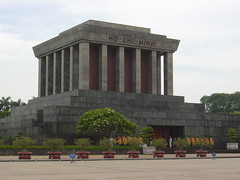
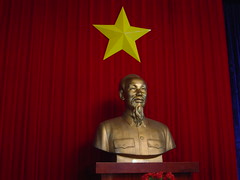
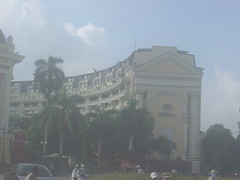
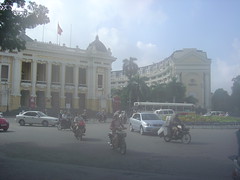
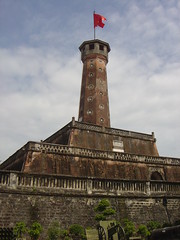
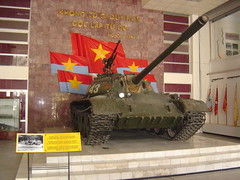
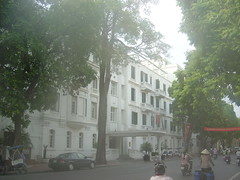
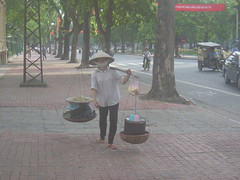
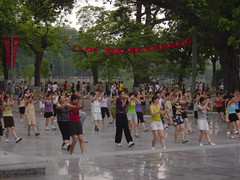
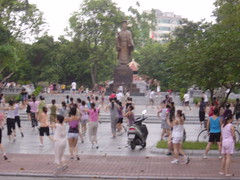
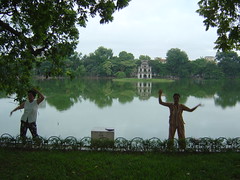
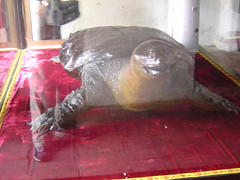
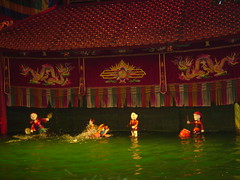
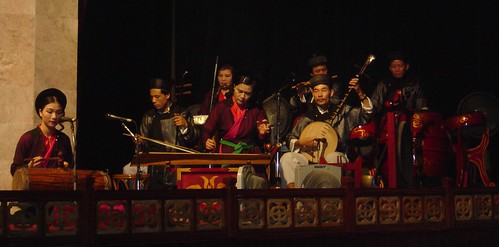
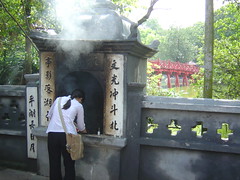
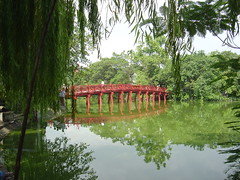
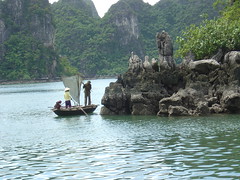
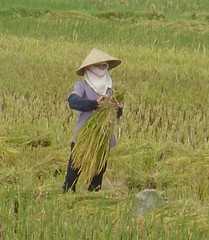
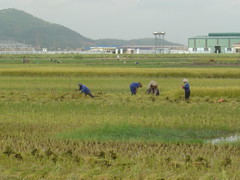 Farmers in the rice fields.
Farmers in the rice fields.